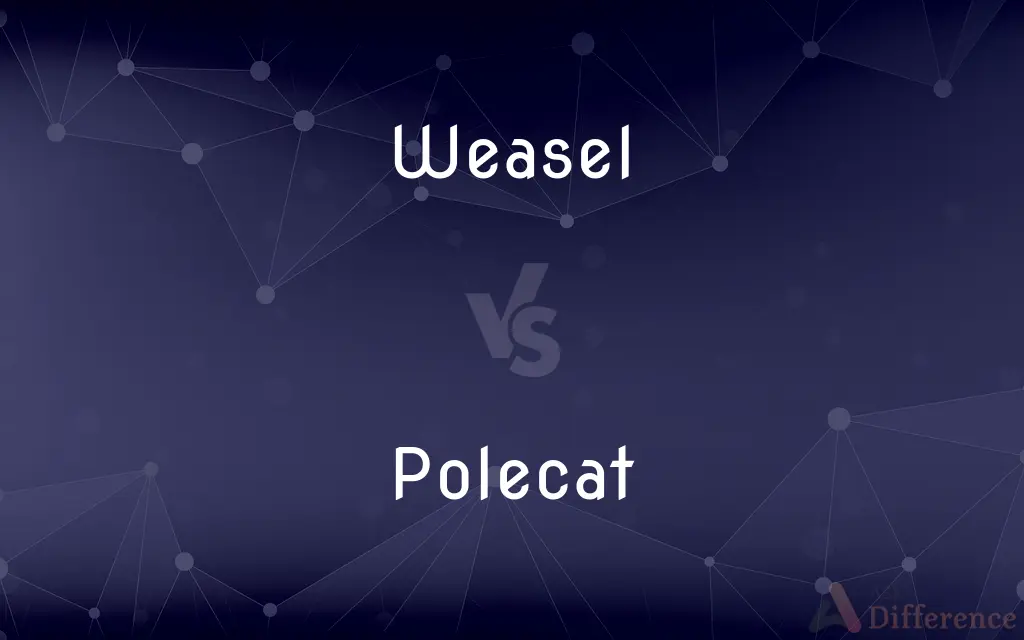Weasel vs. Polecat — What's the Difference?
By Tayyaba Rehman & Maham Liaqat — Updated on April 21, 2024
Weasels are small, nimble carnivores known for their elongated bodies and reddish-brown fur, whereas polecats are larger, stockier relatives with a distinctive musky odor.

Difference Between Weasel and Polecat
Table of Contents
ADVERTISEMENT
Key Differences
Weasels are among the smallest carnivores in the Mustelidae family, characterized by their slender bodies and short legs, which enable agility and stealth. Whereas polecats, also members of the Mustelidae family, are noticeably larger and more robust, adapted to a slightly different hunting style.
In terms of habitat, weasels are highly adaptable and found across a variety of environments from wooded areas to grasslands. On the other hand, polecats prefer woodland edges, farmlands, and areas close to water bodies, which provide ample cover and food sources.
Weasels have a reddish-brown coat with a white underbelly, which provides camouflage in their natural habitat. In contrast, polecats boast a darker, blackish-brown fur with a cream-colored face mask, making them distinctive among their relatives.
Behaviorally, weasels are known for their fierce and energetic hunting techniques, often pursuing prey much larger than themselves. Polecats, however, employ a more methodical approach to hunting, using their strong sense of smell to track down prey before delivering a fatal bite.
Reproductively, weasels have a unique ability known as delayed implantation, allowing them to time the birth of their young according to environmental conditions. Polecats do not have this capability and follow a more traditional breeding cycle.
ADVERTISEMENT
Comparison Chart
Size
Smaller, less than 250 grams
Larger, up to 1,500 grams
Fur Color
Reddish-brown with white underbelly
Darker brown with a cream face mask
Habitat
Wooded areas, grasslands
Woodland edges, farmlands
Hunting Style
Agile and energetic
Methodical and reliant on smell
Reproduction
Delayed implantation possible
Traditional breeding cycle
Compare with Definitions
Weasel
Known for its reddish-brown fur and energetic hunting.
A weasel's fur helps it blend into the forest floor.
Polecat
Recognizable by its cream-colored facial mask.
The polecat's face mask helps differentiate it from similar species.
Weasel
Capable of hunting prey larger than itself.
The weasel attacked a rabbit, demonstrating its bold nature.
Polecat
A robust mustelid with a musky odor and darker fur.
The polecat's musky scent is a distinct characteristic among mustelids.
Weasel
Exhibits delayed implantation for reproductive advantage.
The weasel can delay pregnancy to coincide with spring's abundance.
Polecat
Prefers habitats with ample hiding spots and prey.
The polecat prowled the woodland edge, searching for rodents.
Weasel
Small carnivorous mammal with a long, slender body.
The weasel darted through the underbrush in pursuit of a mouse.
Polecat
Uses a methodical hunting technique.
The polecat tracked its prey carefully before making a move.
Weasel
Adapts to various environments for survival.
Adapting well, the weasel thrived even in a suburban setting.
Polecat
Lacks the reproductive strategy of delayed implantation.
Polecats breed in the early spring without delay.
Weasel
Weasels are mammals of the genus Mustela of the family Mustelidae. The genus Mustela includes the least weasels, polecats, stoats, ferrets and mink.
Polecat
Polecat is a common name for mammals in the order Carnivora and subfamilies Ictonychinae and Mustelinae. Polecats do not form a single taxonomic rank (i.e.
Weasel
Any of various carnivorous mammals of the genus Mustela, having a long slender body, a long tail, short legs, and brownish fur that in many species turns white in winter.
Polecat
A weasel-like Eurasian mammal with mainly dark brown fur and a darker mask across the eyes, noted for its fetid smell.
Weasel
A person regarded as sneaky or treacherous.
Polecat
A chiefly nocturnal mustelid mammal (Mustela putorius) of Europe that ejects a malodorous fluid to mark its territory and defend itself from predators. Also called fitch.
Weasel
To be evasive; equivocate.
Polecat
Either of two similar mammals, Mustela eversmanii of the Central Asian steppes, having a light brown coat with a black mask, or Vormela peregusna of Eurasia, having a mottled yellow and brown coat.
Weasel
The least weasel, Mustela nivalis.
Polecat
See skunk.
Weasel
Any of the carnivorous mammals of the genus Mustela, having a slender body, a long tail and usually a light brown upper coat and light-coloured belly.
Polecat
A weasel-like animal of the genus Mustela.
Weasel
The taxonomic family Mustelidae is also called the weasel family.
Polecat
Notably, the European polecat, Mustela putorius.
Weasel
A devious or sneaky person or animal.
Polecat
A skunk.
Weasel
A type of yarn winder used for counting the yardage of handspun yarn. It most commonly has a wooden peg or dowel that pops up from the gearing mechanism after a certain number of yards have been wound onto the winder.
Polecat
(television) A tubular device used to support lights on a set.
Weasel
(transitive) To achieve by clever or devious means.
Polecat
A small European carnivore of the Weasel family (Putorius fœtidus). Its scent glands secrete a substance of an exceedingly disagreeable odor. Called also fitchet, foulmart, and European ferret.
Weasel
To gain something for oneself by clever or devious means.
Polecat
American musteline mammal typically ejecting an intensely malodorous fluid when startled; in some classifications put in a separate subfamily Mephitinae
Weasel
(intransitive) To engage in clever or devious behavior.
Polecat
Dark brown mustelid of woodlands of Eurasia that gives off an unpleasant odor when threatened
Weasel
Any one of various species of small carnivores belonging to the genus Putorius, as the ermine and ferret. They have a slender, elongated body, and are noted for the quickness of their movements and for their bloodthirsty habit in destroying poultry, rats, etc. The ermine and some other species are brown in summer, and turn white in winter; others are brown at all seasons.
Weasel
Small carnivorous mammal with short legs and elongated body and neck
Common Curiosities
What is the typical size of a weasel?
Weasels typically weigh less than 250 grams and are very small.
Are weasels found worldwide?
Yes, weasels are adaptable and can be found in various environments across multiple continents.
What kind of habitats do polecats prefer?
Polecats prefer woodland edges, farmlands, and areas near water.
How do polecats hunt their prey?
Polecats use a methodical approach, relying heavily on their sense of smell.
Can weasels be kept as pets?
While it's possible, weasels are wild animals and generally not suitable as pets.
What is the lifespan of a polecat in the wild?
Polecats can live up to 5 years in the wild.
How do weasels communicate with each other?
Weasels communicate through scents and vocalizations, particularly during mating season.
Are weasels aggressive animals?
Weasels are known for their fierce nature, especially when hunting or threatened.
How do weasels adapt their reproduction to their environment?
Weasels can delay implantation of embryos, timing births for optimal conditions.
What distinguishes a polecat's appearance from other mustelids?
Polecats have darker fur and a distinctive cream-colored facial mask.
What is delayed implantation in weasels?
It's a reproductive strategy where fertilized eggs delay developing until conditions are favorable.
What are the main threats to polecats in the wild?
Habitat loss and persecution due to their predation on poultry are major threats.
How do weasels manage to hunt larger prey?
Weasels use their agility and boldness to tackle prey much larger than themselves.
What do polecats eat?
Polecats primarily eat small mammals, birds, and amphibians.
Do polecats have any special adaptations for survival?
Their musky odor can deter predators and their camouflage helps in stealth hunting.
Share Your Discovery

Previous Comparison
Foreslash vs. Slash
Next Comparison
Glare vs. ScowlAuthor Spotlight
Written by
Tayyaba RehmanTayyaba Rehman is a distinguished writer, currently serving as a primary contributor to askdifference.com. As a researcher in semantics and etymology, Tayyaba's passion for the complexity of languages and their distinctions has found a perfect home on the platform. Tayyaba delves into the intricacies of language, distinguishing between commonly confused words and phrases, thereby providing clarity for readers worldwide.
Co-written by
Maham Liaqat













































